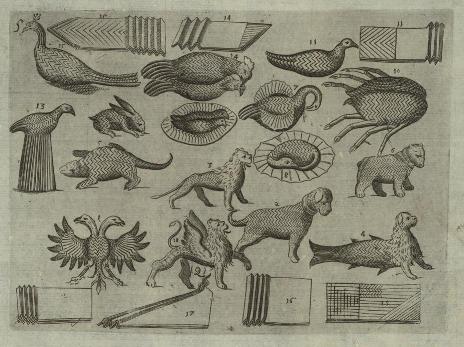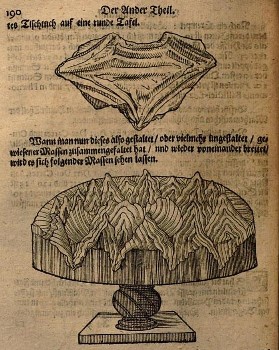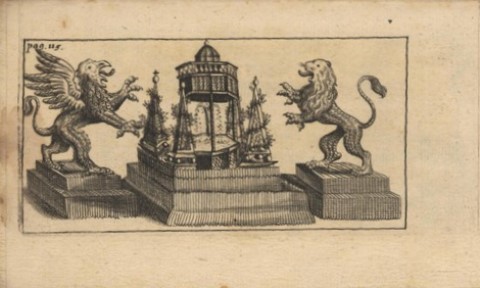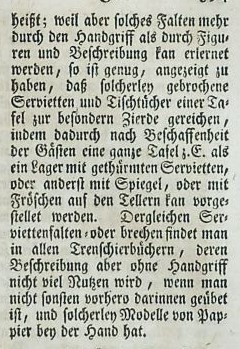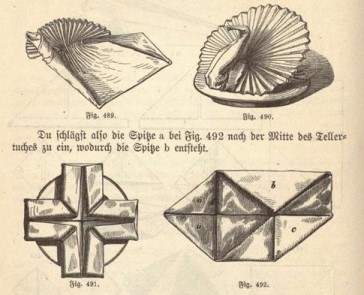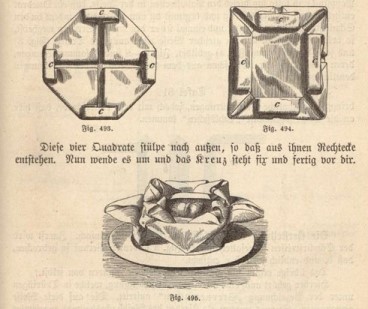| The Public Paperfolding History Project
Last updated 20/10/2024 x |
|||||||
| Tablecloth, Napkin and Serviette Folding | |||||||
| This
page is being used to collect information about
Tablecloth, Napkin and Serviette Folding. Please contact
me if you know any of this information is incorrect or if
you have any other information that should be added.
Thank you. There is a separate page for the folding of handkerchiefs. ********** I have generally not created Individual Design Pages for napkin, serviette and handkerchief folds unless like the Cross, the Bishop's Mitre (the Pipe Cap) or the Lotus they also occur as paperfolds. This Index Page, however, records where napkin and serviette designs appear in the sources so that you could, if you wish, construct a chronology for any relevant design yourself. Many of the references on this page are taken from 'Folded Beauty: The Art of Napkin Folding' by Joan Sallas, which was published by Jong Ie Nara in 2018 (this is an English translation by Edwin Corrie of the author's earlier book 'Gefaltete Schonheit', published in 2010). The Bibliography is particularly useful, and is much more comprehensive than this page, although arranged by author's surname rather than in chronological order. There are two fundamental types of napkin / serviette folding, those which are solely intended for display (which tend to be complex and often sewn together), and those that while still intended to be decorative are also intended to be used by the diners (which tend to be relatively, or absolutely, simple in comparison). Joan Sallas, op cit above, page 116, says, 'Anybody wanting to learn how to fold napkins would first familiarise himself with ways to fold a sheet of paper ...' Unfortunately, as far as I am aware, there is no evidence to back up this statement. In fact there are surprisingly few clearly evidenced connections between napkin / serviette folding and paperfolding. Those that I am aware of are listed here: 1. In 'Aanhangzel volmaakte Hollandsche keuken-meid' (the perfect Dutch kitchen-maid) by Jan Willem Claus van Laar, which , was published in Amsterdam in 1746, there is a passage near the top of page 133 which says, 'indien men met een weinig opplettenheid, het zelve met een stuk papier probeerd' which roughly translates as 'if one, with a little care, tries it oneself with a piece of paper', which suggests that paper was sometimes used to practice napkin folding techniques. 2. The paperfolding entertainment known as 'Troublewit' is first evidenced in 1676 when it appeared in the book 'Sports and Pastimes' which was published in London. This is later than the publication, in Italy and Germany, of napkin folding designs which use similar pleating and cross-pleating techniques, and it is thus possible that Troublewit may have developed out of napkin folding. However, evidence to prove this connection is lacking. 3. ''Escole parfaite des officiers de bouche', which was published by J Ribou in Paris in 1662, contains instructions explaining how to fold serviettes into both a 'Croix de Sainct Esprit' (the Triple Blintz Basic Form) and a 'Croix de Lorraine' (the Cross). Thus it is possible that napkin folding techniques were at least partly the inspiration for the development of some of Frobel's 'Forms of Life'. ********** In Japan (and in books by Japanese authors) 1931 Several napkin folds appear in 'Origami (Part 1)' by Isao Honda, which was first published in Japan in 1931. The names appear in the original text in English as well as Japanese, suggesting that the author learned these folds during his time in the West.
********** 1944 A number of napkin folds also appear in 'Origami Shuko' by Isao Honda, which was published in 1944.
********** In Europe and the Americas 1629 The 'Trattato delle piegature', by Mattia Giegher, which was first published in 1629 contains a section about the folding of napkins.
********** 1652 'Vollständiges und von neuem vermehrtes Trincir-Buch' by Georg Philipp Harsdörffer was published in Nurnberg in 1652. It is largely a book about the carving of meat but also includes a section on the folding of tablecloths and napkins. It includes simple designs as well as very complex ones.
********** 1653 Volume 3 of 'Deliciae physico mathematicae' was a follow up to Daniel Schwenter's 1636 book written by Georg Phillip Harsdorffer, and published in 1653. Pages 189 to 190 contain information about the folding of tablecloths.
********** 1657 'Neues Trenchier-und Plicatur-Büchlein' by Andreas Klett, which was first published in 1657, contains a chapter on tablecloth and napkin folding.
********** 1657 - 1659 During this period Tallemant Des Reaux wrote his 'Historiettes', although they were not published in print until 1836. Book 9 contains mention of a mute man who 'folded linen admirably well into all sorts of animals', although no further details are given. ********** 1662 'L'Escole parfaite des officiers de bouche; contenant le vray maistre-d'hotel, le grand escuyer tranchant, le sommelier royal, le confituriern royal, le cuisinier royal et le patissier royal', which was published by J Ribou in Paris in 1662, contains instructions explaining how to fold serviettes (but no illustrations) including a 'Croix de Sainct Esprit' (the Triple Blintz Basic Form) and a 'Croix de Lorraine' (the Cross) ********** 1682 'A Perfect School of Instructions for the Officers of the Mouth: Shewing the whole art of A Master of the Houshold, A Master Carver, A Master Butler, A Master Confectioner, A Master Cook, A Master Pastryman' by Giles Rose, published by R Bentley and M Magnes in London in 1682, is an English translation / paraphrase of 'L'Escole parfaite des officiers de bouche'. ********** 'Il Cuoco Francese' by Signor de la Varenne, also published in 1682, includes an Italian translation / paraphrase of the napkin folding material from 'L'Escole parfait des officiers de bouche'. ********** 1688 In the Earl of Castlemaine's account of his embassy from James II to Innocent XI, published in English in 1688 but earlier in Italian, he mentions 'Napkins (which were also most artificially folded)' ********** 1699 'Vollständige Haus-und Land-Bibliothec' by Andreas Glorez, 1701. ********** 1724 The satire 'Description de Lisle des Hermaphrodites' by Thomas Artus, which was published in 1724, refers to 'Les autre serviettes qui estoient a l'entour de la table estoient desguisees en plusieurs fortes de fruicts and d'oyseaux: and comme je m'amusois a considerer cette industrie (non sans admiration de la perte du temps que l'on faifoit a l'exercice d'une chose si vaine) ...' (The other serviettes which were around the table were disguised as many kinds of fruits and birds: and I amused myself considering this industry (not without admiration for the waste of time spent doing such a vain thing) ...' ********** 1746 'Aanhangzel volmaakte Hollandsche keuken-meid' (the perfect Dutch kitchen-maid) by Jan Willem Claus van Laar was published in Amsterdam in 1746. It contains some pages about napkin folding. ********** 1759 Columns 593/4 of 'Onomatologia curiosa artificiosa et magica oder ganz natürliches Zauber-lexicon', which was published in 1759, contains a short section about serviette folding. The last sentence says, roughly, 'Such serviette folds can be found in many books about butchery, the description of which, however, will not be of much use if you are not otherwise practiced at making them or have paper models to hand.'
********** 1797 'Praktischer Unterricht in der neuesten Art des Tafeldeckens und Trenschirens', which was published in Vienna in 1797, contains a brief comment about napkin folding which reads, 'Then the tablecloth and serviettes must be 6 quarters long and 5 wide, and the tablecloth must also hang over a few feet by half a cubit. If you can fold the serviettes it's all the better, it adorns and fills the table, even though nowadays (this skill has) badly declined, and on the tables of distinguished persons they are simply left square, presumably because people find it very difficult, the serviettes are not enhanced, but most people lack the knowledge.' (Translation by Edwin Corrie. Words in brackets interpolated to help the sense.) ********** 1808 'Almanach des Gourmands', 1808 contains a section about napkin folding which both refers to, and is largely based on, 'L'Escole parfaite des officiers de bouche'. ********** 1835 'Encijclopedie of Handboek' by A B van Meerten, which was published in 1835, contains a brief mention of napkin folding and an illustration of a few simple designs. ********** 1845 'Leichtfasslicher Unterricht in der Kunst die Servietten ...' by Friedrich Kaspar Funke, 1845 ********** 1854 'Table Observances', which was published in 1854, contains instructions for folding a few simple designs and some information on how they should be used. ********** 1855 'The Practical Housewife' by Robert Kemp Philp, which was published by Ward and Lock in London in 1855, also contains a useful section on napkin folding. ********** There is mention of the 'napkin-folding mysteries of certain steamboat-stewards and restaurants' on page 242 of Charles Dickens magazine 'Household Words' of 13th October 1855. ********** 1865 'Spielbuch fur Madchen' by Maria Leske, which was published by Verlag von Otto Spamer in Leipzig in 1865, contains some illustrations of simple napkin folds.. ********** 1868 'Warne's Model Cookery' by Mary Jewry, was published by Frederick Warne and Company in London in 1868. It contains folding directions for three napkin / serviette folds, including an unusual folding method for the Cross. ********** 1869 Volume 3 of 'Cassell's Household Guide', which was published by Cassell, Petter and Galpin in London and New York in 1869, contains instructions for preparing and folding serviettes into various designs. ********** 1874 There is a section on the folding of napkins in 'Spiel und Arbeit' by Hugo Elm, which was published by Verlag und Drud der Otto Spamer in Leipzig in 1874.
********** 1875 'A Book about the Table' by John Cordy Jeaffreson, which was published by Hurst and Blackett in London in 1875 contains information about the history of napkins, an intriguing theory as to why the ornate folding of napkins arose, and refers in some detail to 'A Perfect School of Instructions for the Officers of the Mouth' by Giles Rose. ********** 'Dinner Napkins and How to Fold Them' by Georgiana G Clarke, 1875 ********** 1876 'Des Kindes Erste Beschaftigungsbuch' by E Barth and W Niederley contains a short section about serviette folding. ********** 1879 'Die Speisetafel und ihr Arrangement' by Maria Wurm, 1879 ********** 1882 'The Kindergarten Guide' by Maria Kraus Boelte and John Kraus, which was first published in single volume form by E. Steiger and Company in New York in 1882, contains a short section about napkin folds. None of the folds are named. ********* 1887 'Le maître et la maîtresse de maison' by Mme Louise d'Alq, 1887 ********** 1888 'How To Fold Napkins: Appendix to the Steward's Handbook', which was published in Chicago in 1888, is a 24 page guide to the folding of napkins and serviettes. ********** 1890 'Serviettes and How to Fold Them' was published in 1890 by Robinson and Cleaver of Belfast to promote their range of household linens. ********** 'La Salle à manger : revue de la table et de l'office' which was published in paris in June 1890 contained a paragraph about serviette folding, which, roughly translated, read: 'The folding of serviettes has acquired such importance in America, that it is published special journals, it seems, giving paper models for this kind of study. The linen is usually scented with cedar or sandalwood, or laid, not on a plate, but on the tablecloth, with a bouquet of buttonholes, and a bun ...! as big as a nut. — If you find these fashions in some wealthy American living in Paris, do not look surprised. Before putting an end to the towels, let us recall for the edification of the curious, that the Japonese use rice paper, which is naturally thrown away at the end of the meal, and that the proud Romans, going to dinner at Lucullus' house, each brought their own serviette.' ********** 1891 'Le Livre de la Femme D'Intérieur' par Oscar-Edmond Ris-Paquot, 1891 ********** 1892 In an article titled 'Notes Mondaine' in the issue of the French periodical 'Les Annales politiques et littéraires : revue populaire paraissant le dimanche' for 1st October 1892, the Baronne Staffe wrote, roughly translated: 'The serviettes are also folded to offer the appearance of a pair of slippers. Let us open a parenthesis here. Becoming ever more delicate, more refined, a large number of people would like to find a folded serviette as it came out of the hands of the laundress. It is unpleasant for them to think that this cloth that wipes their lips has been handled and reworked by a butler to give it a more or less amazing shape. The complicated folding of serviettes could only be accepted on the condition that the mistresses of the house or their daughters would take care of carrying out these works of art. This is done in America. The butler brings the snowy linen in baskets to the ladies of the house, and it is they who give him the aspect of a fan, an egret peacock, shoes, etc. But nothing beats the serviette as it comes out of the smoke cabinet.' ********** 1895 Article in 'La Joie de la Maison', 8th August 1895 ********** 1898 'Le Guide de la Femme du Monde' by La Marquise de Pompeillan, 1898. ********** 'The Housewife's Referee' by Mrs de Salis was published by Hutchinson and Co in London in 1898. It contains a chapter on Napkin Folding. ********** 1899 'L'Art de Plier les Serviettes de Table' by Agnes Verboom was published in 1899. ********** 1900 'La Cuisine Pratique de Francoise', which was published in 1900, contains a chapter on serviette folding. ********** 1907 The 1907 edition of 'Mrs Beeton's Book of Household Management' included a chapter on serviette folding. ********** 1922 'La cuisine et la table modernes' by various contributors, which was published by Librairie Larousse in Paris in 1922 contained a brief sentence about serviette folding which, roughly translated, read: 'Serviettes should be folded simply and not present those whimsical forms that disparage the most elegantly set table.' The accompanying instructions presumably present one of the approved simple forms. ********** 1923 'More Paper Magic' by Will Blyth, which was published by C Arthur Pearson in London in 1923 contains diagrams for several serviette folds. ********** 1928 An article which appeared in the issue of the French periodical 'Le Petit écho de la mode' of 26th February 1928 states: 'Fashion advises us to avoid the folding of serviettes into too complicated shapes; but it is not opposed to what we seek to renew somewhat the simple line of serviettes laid flat'. ********** 1941 'After The Dessert' by Martin Gardner, which was published in 1941, contains the 'Improvised Brassiere' napkin fold. *********** 1943 'Fun at Dinner with Napkin Folds' by Tom Osbourne , 1943. ********** 1945 'Napkin Folding' by Tom Osbourne, 1945 is a complete book about napkin folding. ********** 1963 'Party Lines' by Robert Harbin, which was published by the Olbourne Book Co in London in 1963, contains diagrams for making a number of napkin folds. ********** |
|||||||


